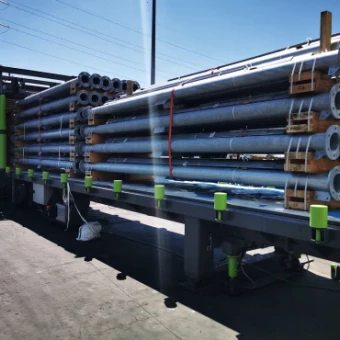Unloading Containers: How to Improve Efficiency?
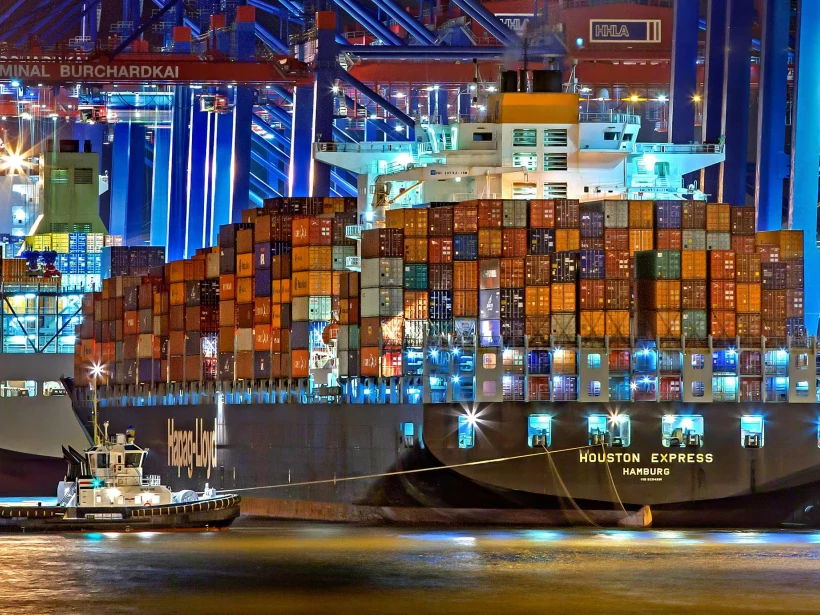
Efficient container unloading is vital for seamless logistics operations. Whether you're a warehouse manager, logistics expert, or someone looking to streamline processes, mastering this task can save you both time and money.
Inefficient unloading can cause up to 20 hours of delays weekly, creating supply chain bottlenecks and increasing operational costs.
This impacts delivery timelines and reduces productivity at ports and warehouses, underscoring the need for optimized unloading systems. In this guide you’ll find best practices, safety tips, and smart tools for professional container unloading.
Discover how SmartTEH Container Unloading System can simplify this task and transform it into a smooth operation. Let’s first explore the traditional unloading process to appreciate advancements in container loading and unloading technology.
Key takeaways
- Traditional container unloading methods are labor-intensive, leading to higher costs and increased safety risks for workers.
- Modern unloading methods utilize mechanized solutions automated or robotic container unloading systems, improving efficiency and safety while reducing labor needs.
- The SmartTEH Container Unloading System enhances workflow efficiency, reduces labor costs, and significantly improves safety and compliance in container handling operations.

The traditional container unloading method
The traditional method of container unloading is manual or semi-automated, which remains widely used by small to medium businesses, industries handling non-standardized cargo, and seasonal operations. This approach relies heavily on human labor and basic equipment, making it a practical choice for many.
Here’s how it usually goes:
Initially, the container is positioned at the unloading area, often a loading dock or a designated space within a warehouse. Workers equipped with straps and pallet jacks begin the labor-intensive task of manually unloading the cargo. This process involves physically lifting and moving goods, which can be strenuous and time-consuming, particularly when dealing with awkwardly shaped or heavy items.
For businesses dealing with varied and complex transport needs, the traditional method presents significant challenges.
Challenges of the conventional approach
The lack of advanced container handling equipment means that each piece of cargo must be carefully maneuvered to avoid damage, requiring a high level of skill and experience from the workers involved. This method often results in prolonged unloading times and increased labor costs, as more hands are needed to manage the workload effectively.
Moreover, the manual nature of this process heightens the risk of accidents and injuries, with workers frequently exposed to potential hazards like falling items and physical strain. The reliance on human strength and coordination makes it difficult to maintain consistent efficiency, leading to delays and potential disruptions in container handling operations.
Despite these challenges, some businesses continue to employ traditional unloading methods due to budget constraints or the nature of their cargo. However, as the logistics industry evolves, there is a growing recognition of the need to adopt more advanced solutions that enhance safety, efficiency, and cost-effectiveness in the unloading process.
Many businesses are now turning to modern solutions like automated systems (e.g., SmartTEH) to improve efficiency, safety, and speed.
How to unload a container safely
Ensure that everyone in the team is aware of safety requirements.
• Create secure working conditions by providing ample space for equipment movement and adequate lighting to mitigate risks.
• Choose an optimal unloading method—live unload, drop and return, or using a loading dock—to maintain safety and efficiency.
• Ensure personnel protection with appropriate personal protective gear (PPE) during the container offloading process at the dock.
• Survey the area for potential hazards before unloading and secure any dislodged cargo to prevent accidents or injuries.
• Utilize suitable tools like forklifts or pallet jacks to improve productivity when removing goods from containers.
• Conduct post-unload examinations to assess damage and confirm cleanliness around the docking station, preventing future complications.
These actions collectively ensure a secure approach to unloading, enhancing overall operational effectiveness.
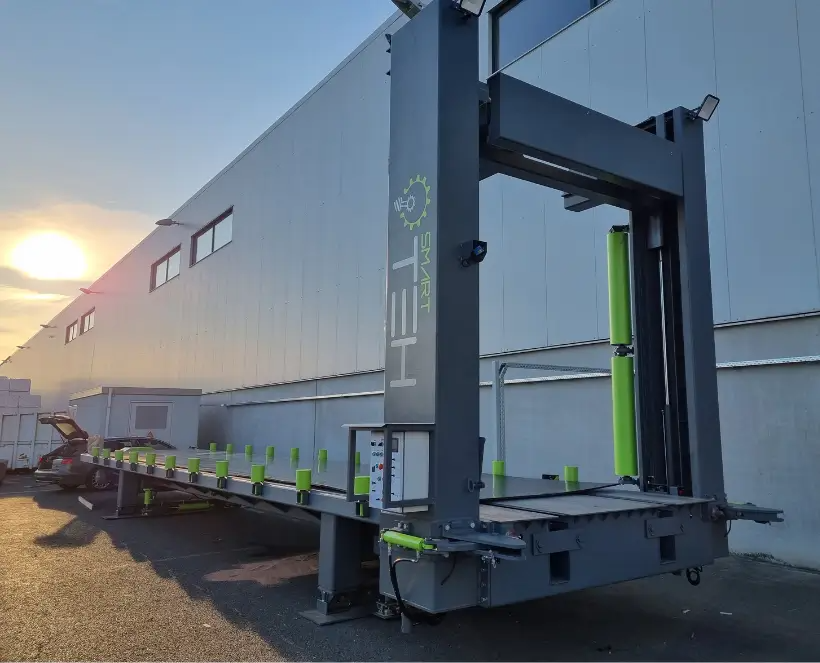
The modern container unloading method
Modern warehouse container unloading methods have revolutionized logistics by incorporating automation and specialized equipment, significantly reducing the reliance on human labor. This transformation enhances the efficiency and safety of operations.
Benefits of modern unloading methods:
• Faster unloading times: automated systems expedite cargo handling, minimizing delays and increasing throughput.
• Enhanced safety: by reducing the need for manual heavy lifting, these methods mitigate risks associated with falling objects and physical strain.
• Lower labor costs: dependence on large workforces is diminished, maintaining productivity with fewer personnel.
• Reduced product damage: precision-controlled unloading minimizes mishandling and breakage, ensuring goods remain intact.
• Optimized workflow: seamlessly integrates with warehouse and logistics operations, streamlining processes and boosting overall efficiency.
Cutting-edge equipment is at the heart of modern container unloading techniques, maximizing these advantages. Here's a look at the top solutions for efficient container unloading:
Container loading technologies
When it comes to modernizing container loading operations, several advanced technologies can significantly enhance efficiency and safety. Here are some notable options:
- Automated container unloading systems: these systems use robotics and automation to unload containers quickly and safely, reducing the need for manual labor and minimizing the risk of injury.
- Telescoping belts: the extendable conveyor belts can reach deep into containers, allowing for efficient loading and unloading of goods. They are particularly useful for handling loose items and can be adjusted to various lengths to accommodate different container sizes.
- Robotic palletizers: they automate the stacking and arranging of goods onto pallets, streamlining the loading process and ensuring optimal use of container space.
- Automated Guided Vehicles (AGVs): AGVs are used to transport goods within a warehouse or loading area, reducing the need for forklifts and improving safety and efficiency in container handling operations.
- Smart container tracking systems: these systems use IoT technology to monitor and track containers in real-time, providing valuable data on location, temperature, and other conditions to optimize logistics operations.
- Dock levelers and ramps: These tools facilitate smooth transitions between different loading surfaces, ensuring safe and efficient loading and unloading processes.
By integrating these technologies, businesses can optimize their container handling operations, improve workflow efficiency, and enhance overall productivity. Let’s talk a little more about the first one—the automated container unloading systems.
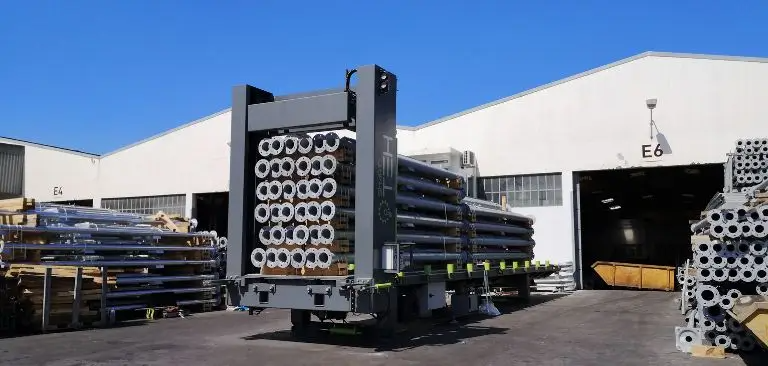
The SmartTEH Container Unloading System (CLS-U) automates and optimizes cargo loading into shipping containers. Utilizing a specialized sliding platform (an advanced conveyor system), it precisely lifts, guides, and positions cargo, effectively eliminating the need for manual labor and drastically reducing loading times. See how it works in this animation:
The SmartTEH CLS adeptly manages a wide variety of cargo types—from heavy cargo like steel pipes to delicate items—ensuring meticulous care and precision across all categories.
By integrating the SmartTEH CLS into their logistics processes, companies can expect noticeable improvements in workflow productivity, substantial labor cost savings, and enhanced safety protocols during complex transport tasks.
Let’s talk about the industries that benefit most of the CLS system and then go over the benefits of the system itself.
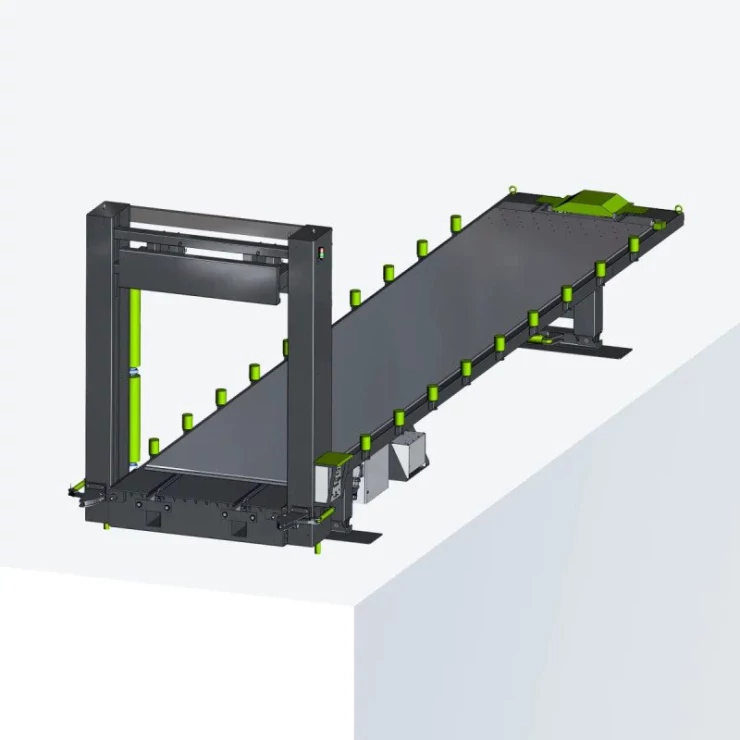
Automatic container loading system
Industries benefiting from SmartTEH Container Unloading System
The SmartTEH CLS is revolutionizing material handling across diverse industries.
- Woodworking industry
In the woodworking sector, this cutting-edge container loading system has significantly reduced labor costs and minimized product damage. By leveraging SmartTEH CLS, heavy items are swiftly and safely loaded, saving time and safeguarding valuable goods.
- Metalworking companies
Metalworking companies have experienced enhanced efficiency and reduced costs by integrating SmartTEH technologies. This advanced Container Unloading System expertly manages heavy loads with precision, thanks to state-of-the-art container handling equipment and industrial engineering.
- Manufacturers and logistics providers
Manufacturers and logistics providers benefit immensely from SmartTEH systems, enjoying expedited loading times and seamless material movement within their supply chains. Here are all the benefits of the automated Container Unloading System.
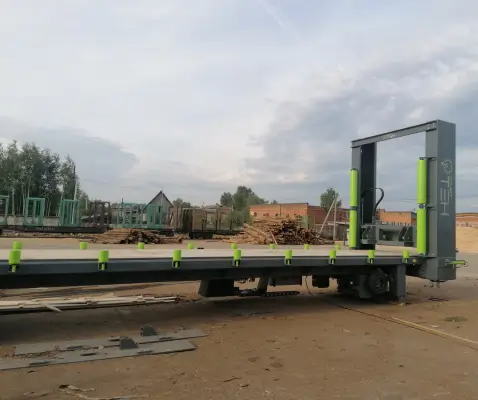
Advantages of the Container Unloading System
In short, the implementation of a modern Container Unloading System like SmartTEH CLS revolutionizes logistics by streamlining operations, cutting down time and labor, and enhancing safety and precision. These systems automate the unloading process, leading to faster turnaround times, reduced risk of damage, and safer working conditions.
Advanced technology ensures better space utilization, lowering shipping costs and boosting efficiency. This gives companies a competitive edge by reducing operational costs and increasing productivity.
Let’s take a closer look.
1. Improved workflow efficiency
Incorporating SmartTEH CLS into container handling operations can markedly improve the efficiency of workflows. Here’s how:
• Reduced loading/unloading time: the system cuts down the time needed to load or unload a container from half an hour to less than 10 minutes, leading to a more efficient and productive process.
• Decreased labor costs: by automating warehouse logistics with tools like the SmartTEH CLS-U, businesses can significantly reduce labor expenses while enhancing operational efficiency.
• Maximized unloading-dock space: an organized unloading process frees up valuable warehouse or docking space, allowing businesses to optimize storage and logistics planning. Efficiently clearing out containers helps maintain a steady workflow without unnecessary congestion in loading and unloading areas.
• Streamlined work environment: the unloading system's structured and automated approach fosters a more organized and efficient workspace. It eliminates the clutter and inconsistencies associated with manual unloading, improving operational flow and ensuring systematic cargo handling.
• Improvement inventory management: leveraging technology within logistical systems streamlines inventory oversight, bolsters stock management accuracy, and minimizes unnecessary waste.
• Customizable features: the ability to customize the SmartTEH CLS with features such as remote control functionality enhances operational agility and safety standards.
These advancements contribute not only to heightened productivity but also facilitate a smoother, more optimized workflow throughout various logistic processes.
2. Cost savings and competitive edge
Integrating SmartTEH systems into operations can lead to significant cost reductions and provide a competitive advantage. Here are the key benefits:
• Substantial labor cost reduction: incorporating SmartTEH equipment can cut labor expenses by up to 60%. The system's automated features enable one individual to handle tasks that previously required an entire team.
• Enhanced space utilization: SmartTEH CLS optimizes cargo hold space usage, resulting in considerable financial savings.
• Improved shipment accuracy: technological solutions like SmartTEH’s automated loading systems not only reduce overheads but also enhance accuracy in shipments, strengthening businesses' positions in the logistics arena.
• Increased product protection: the system ensures gentle and precise handling, reducing the risk of product damage during unloading. This is crucial for fragile or high-value cargo, ensuring goods arrive at their destination in perfect condition, minimizing losses due to damage.
In short—by adopting SmartTEH CLS, enterprises can refine their container handling procedures, achieving cost savings, improved efficiency, and enhanced safety standards.
3. Safety and compliance
The SmartTEH system is associated with a marked decrease in workplace incidents, leading to heightened safety during handling procedures. By incorporating the SmartTEH CLS into operations, there’s a notable decline in on-the-job injuries, thereby boosting overall employee protection.
The introduction of automated unloading systems minimizes the necessity for personnel to physically enter containers, which substantially reduces worker exposure to hazards. Adopting established safety measures assists organizations in aligning with both OSHA and EU directives, diminishing potential workplace mishaps.
Through its adherence-promoting design, the SmartTEH CLS strengthens conformance to these critical safety standards mandated by OSHA and EU regulations.
In sum, the SmartTEH CLS stands as an effective solution that bolsters security protocols while ensuring compliance with necessary regulatory criteria.
Finally, here’s a comparison table to illustrate the value one Container Unloading System can bring to a business.
| Factor | Traditional unloading | Unloading with the Container Unloading System |
| Speed | It takes several hours per container | Completes unloading in under 10 minutes |
| Safety | High risk of worker injuries due to manual handling | Minimizes manual handling, significantly reducing injury risk |
| Labor costs | Requires a large team of workers | It needs only one operator, drastically cutting labor costs |
| Cargo protection | High risk of product damage from manual errors | Precision-controlled unloading ensures cargo safety and integrity |
| Space utilization | Often inefficient use of container space, leading to higher shipping costs | Optimizes space utilization, reducing shipping costs significantly |
| Efficiency | Relies heavily on human coordination, prone to errors | Automated operations ensure consistent, error-free performance |
| Flexibility | Limited adaptability to different cargo types | Easily adaptable to various cargo types and sizes |
| Environmental impact | Higher energy consumption due to prolonged operations | Reduced energy usage through faster |
What’s your choice?
In industries where time, efficiency, and safety are crucial, the SmartTEH Container Loading System (CLS) is a great and needed assistant. It loads and unloads full containers in under 10 minutes, reducing truck waiting times, minimizing manual labor, and optimizing cargo space utilization to 100% while lowering shipping costs and increasing productivity.
If you’re looking for the best way to handle heavy, oversized, and bulk materials, ensuring safe and damage-free transport—consider SmartTEH.

